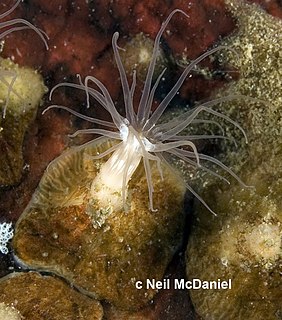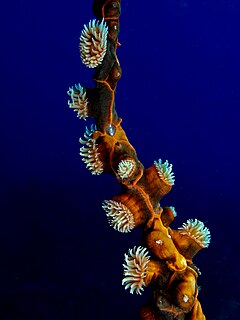
Octineon is the sole genus of sea anemones in the monotypic family Octineonidae.

Tube-dwelling anemones or ceriantharians look very similar to sea anemones but belong to an entirely different subclass of anthozoans. They are solitary, living buried in soft sediments. Tube anemones live inside and can withdraw into tubes, which are composed of a fibrous material made from secreted mucus and threads of nematocyst-like organelles known as ptychocysts. Within the tubes of these ceriantharians, more than one polyp is present, which is an exceptional trait because species that create tube systems usually contain only one polyp per tube. Ceriantharians were formerly classified in the taxon Ceriantipatharia along with the black corals but have since been moved to their own subclass, Ceriantharia.

Ivell's sea anemone is a species of sea anemone in the family Edwardsiidae. It is endemic to a single location, Widewater Lagoon in West Sussex, England, where it was first discovered by Richard Ivell. It has been listed as Data Deficient by the IUCN since 1996.

Edwardsia is a genus of sea anemones, the type of the family Edwardsiidae. They have eight mesenteries and live in tubes in the sand. The name, in New Latin, commemorates the French zoologist Henri Milne-Edwards.

Aiptasia is a genus of a symbiotic cnidarian belonging to the class Anthozoa. Aiptasia is a widely distributed genus of temperate and tropical sea anemones of benthic lifestyle typically found living on mangrove roots and hard substrates. These anemones, as well as many other cnidarian species, often contain symbiotic dinoflagellate unicellular algae of the genus Symbiodinium living inside nutritive cells. The symbionts provide food mainly in the form of lipids and sugars produced from photosynthesis to the host while the hosts provides inorganic nutrients and a constant and protective environment to the algae. Species of Aiptasia are relatively weedy anemones able to withstand a relatively wide range of salinities and other water quality conditions. In the case of A. pallida and A. pulchella, their hardiness coupled with their ability to reproduce very quickly and out-compete other species in culture gives these anemones the status of pest from the perspective of coral reef aquarium hobbyists. These very characteristics make them easy to grow in the laboratory and thus they are extensively used as model organisms for scientific study. In this respect, Aiptasia have contributed a significant amount of knowledge regarding cnidarian biology, especially human understanding of cnidarian-algal symbioses, a biological phenomenon crucial to the survival of corals and coral reef ecosystems. The dependence of coral reefs on the health of the symbiosis is dramatically illustrated by the devastating effects experienced by corals due to the loss of algal symbionts in response to environmental stress, a phenomenon known as coral bleaching.

Nematostella is a genus of sea anemones in the family Edwardsiidae. Of the three species in the genus, the best known is the starlet sea anemone, which has been extensively studied as a model organism in fields such as genetics, evolution, and ecology. The defining morphological apomorphy of Nematostella is the presence of nematosomes.

Alicia is a genus of sea anemones in the family Aliciidae and contains the following species:

Amphianthus is a genus of sea anemones. It is the only genus in the monotypic family Amphianthidae.

Hormathiidae is a family of sea anemones in the class Anthozoa.

Nemanthus is a genus of sea anemones. It is the only genus in the monotypic family Nemanthidae.

Sagartiidae is a family of sea anemones.

Pseudactinia is a genus of sea anemones in the family Actiniidae.

Isanthidae is a small family of sea anemones in the class Anthozoa.

Aiptasiidae is a family of sea anemones, comprising the following genera:

Edwardsia claparedii is a species of sea anemone in the family Edwardsiidae.

Edwardsiella is a genus of sea anemones in the family Edwardsiidae. It is named in honour of Henri Milne-Edwards, an eminent French zoologist.

Bolocera is a genus of sea anemone in the family Actiniidae.

Boloceroides is a genus of sea anemones in the family Boloceroididae. It contains the following species:
Edwardsia delapiae is a species of sea anemone which is currently only known from its type locality in South-West Ireland.
Milne-Edwardsia is a genus of cnidarians belonging to the family Edwardsiidae.

















